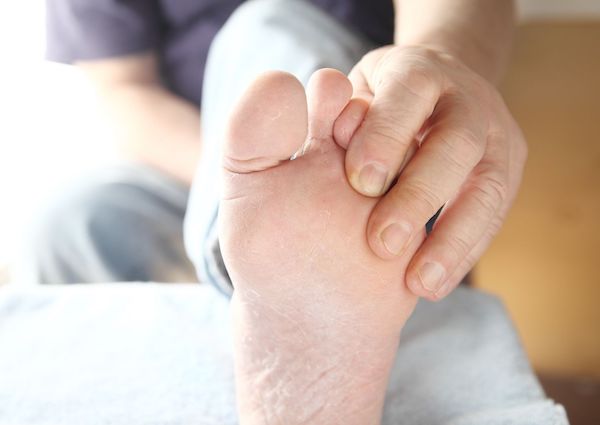Athlete’s foot is a contagious fungal infection medically known as tinea pedis that thrives in warm, moist areas.

While it typically affects feet, athlete’s foot on hands – particularly around the fingernails and on the palms – can also occur. Most commonly though, this fungal infection begins between the toes, usually in people whose feet have become very sweaty due to being confined in tight-fitting shoes.
It is caused by one of two types of fungus, that is, tricophyton mentagrophytes or tricophyton rubrum.
It is spread through direct contact or contact with items such as shoes, stockings, and pool or shower surfaces.
What are its symptoms?
Symptoms of athlete’s foot include:
- Itching and flaking of skin most commonly between toes (interdigital) but also over the foot in general.
- Inflammation may also occur around infected areas. This sometimes becomes secondarily infected with bacteria.
- Skin may appear severely dry but does not improve with moisturising and may result in painful cracks between the toes.
- Athlete’s foot blisters may develop which become painful and itchy and don’t heal well without fungal treatment.
- Affected toenails become discoloured, thick and break easily.
How is it diagnosed?
Doctors can diagnose the condition after taking a look at the infected area. However, they can confirm diagnosis by taking a scraping of the skin known as a KOH exam, or by taking a skin culture.
Athlete’s foot and diabetes are closely associated, which means it is essential to go see a doctor if you have recurrent fungal infections. A combination of athlete’s foot treatment and good management of diabetes will ensure the fungal disease clears up.
What are your treatment options?
Athlete’s foot treatment is achieved through daily application of anti-fungal creams and powders, lasting two to three weeks. When the toenails are affected, treatment is often prolonged for six weeks, oral anti-fungal agents will be needed to treat this.
Doctors advise that you keep the skin clean and dry to discourage fungal growth, particularly between toes. This includes avoiding closed shoes that might provide a moist, warm environment in which the fungus will grow.
Following a careful regimen of keeping feet clean and dry, as well as applying fungal cream daily – even after the symptoms have cleared – is the key to athlete’s foot cure.
Can it be prevented?
Here are a few ways to prevent athlete’s foot:
- Keep infected areas clean and dry
- Opt for open sandals to ensure your feet stay dry and sweat-free
- Avoid walking barefoot in public areas or in change rooms
- Do not share shoes and socks with others
- Always wash hands after coming into contact with infected areas
What to do now
If you’re experiencing recurrent fungal infections and are concerned you may have diabetes, Clicks Clinics will help you prevent, identify and manage diabetes with their wide range of screening tests and health assessments. These include:
- Glucose Screening with Consultation
- Urine Test (tests for blood, protein and glucose)
- Blood Pressure Test
- Cholesterol Testing and Consultation
- Lipogram Blood Test (to determine different types of cholesterol)
- Foot Screening Consultation (to check for diabetes-related foot problems)
- Clicks Full Basic Screening (BP, Body Mass Index or BMI, meal guide and exercise plan)
- Clicks Screening Measurements only (BP and BMI)
- Clicks Comprehensive Screening (BP, BMI, Glucose and Cholesterol screening, plus meal and exercise plan).
To make an appointment at a Clicks Clinic, call 0860 254 257 or visit Clicks Clinics online and the Clicks Diabetes Management Programme.
IMAGE CREDIT: 123rf.com
